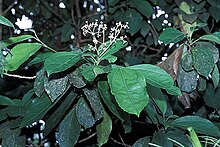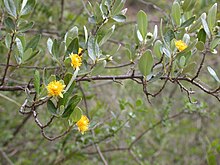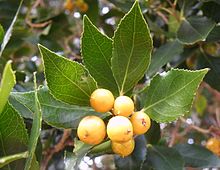Willow plants
| Willow plants | ||||||||||||
|---|---|---|---|---|---|---|---|---|---|---|---|---|

Trembling Poplar ( Populus tremula ), illustration |
||||||||||||
| Systematics | ||||||||||||
|
||||||||||||
| Scientific name | ||||||||||||
| Salicaceae | ||||||||||||
| Mirb. |
The willow family (Salicaceae) are a family in the order of the Malpighia-like (Malpighiales) within the flowering plants (Magnoliopsida).
description

Appearance and leaves
They are deciduous or evergreen woody plants that grow as trees or shrubs . Some species form clones through root shoots, rhizomes, subsidence or division of the stem axis. The branching is monopodial or sympodial. The upright to hanging stem axes have a bare or downy hairy bark .
In some species there is heterophylly : there are different leaves in the youth and age forms. The mostly alternate and mostly spiral, sometimes two-line, but rarely more or less opposite (for example Salix purpurea ) arranged leaves are usually petiolate. The simple leaf blades have toothed or smooth leaf margins and sometimes glands. Stipules may be present.
Inflorescences and flowers
All species native to Central Europe and almost all other species of willow family in their original size (Salicaceae s. Str.) Have in common that they are dioecious, separate sexes ( diocesan ), which means that only either female or male flowers are formed on a plant specimen . With the Salicaceae s. st. there are usually many flowers of the same sex grouped together in elongated, racemose or spike-like inflorescences, the so-called catkins , which stand or hang upright. The newly added genera are more often hermaphroditic or, more rarely, monoecious, separate sexes ( monoecious ) and the flowers are not in kitten-shaped inflorescences. If the inflorescences are not catkin-shaped, then they are sometimes bundled or grape-like cymes . There may be inflorescence stems. Flower stalks are present or absent.
Male flowers contain two to many stamens . Female flowers contain an ovary with a stylus.
The poplar species are pollinated by the wind, while the willow species are predominantly insect pollinated ("bee forage plants" in spring). The flowering time of the wind-pollinated species is at least before the development of the leaves, otherwise the flowering time takes place depending on the species at different times of the year.
Fruits and seeds
The Salicaceae s. st. two- to fourfold (rarely fivefold) capsule fruits that contain four to many seeds, or with the former Flacourtiaceae berries or, more rarely, stone fruits . In the species with capsule fruits, the seeds are spread by the wind and have a basal head of hair.







Systematics and distribution
The Salicaceae family was established in 1815 by Charles François Brisseau de Mirbel in Elémens do Physiologie Végétale et de Botanique , Volume 2, S 905, there under the name "Salicineae". While previously only three genera , namely the willow ( Salix ), poplar ( Populus ) and Chosenia were classified in the Salicaceae, numerous genera that were formerly included in the family of the Flacourtiaceae now also belong to it. The family Salicaceae s. l. thus contains about 55 genera with about 1010 species . Synonyms for Salicaceae Mirb. s. l. are: Bembiciaceae RCKeating & Takht. , Caseariaceae Tree .-- Bod. , Flacourtiaceae Rich. ex DC. , Homaliaceae R.Br. , Patrisaceae Mart. , Prockiaceae Bertuch , Samydaceae Vent. , Scyphostegiaceae Hutch.
The Salicaceae sl are distributed almost worldwide. They are originally missing in Australia only on the east coast and in New Zealand. Poplar species and willow species occur mainly in the temperate areas of the northern hemisphere in humid locations; they are also found in tundras and in the mountains above the tree line. In North America there are four genera with about 123 species.
- Salicaceae s. st. :
- Willows ( Salix L. ): The approximately 450 species are distributed almost worldwide.
- Poplars ( Populus L. ): The 32 to 100 species are distributed worldwide.
-
Chosenia Nakai : It contains only one species:
- Chosenia arbutifolia (Pall.) AKSkvortsov , sometimes also placed with Salix : It comes in Russia in Chita , Irkutsk , Sakha (Yakutia) , Amur , Kamchatka , Khabarovsk , Magadan , Primorye and Sakhalin , in the Chinese provinces of Hebei , Heilongjiang , Jilin , Liaoning and eastern Nei Monggol , on the Japanese islands of Hokkaidō and Honshū and in Korea .
- former Flacourtiaceae: Many of the more than 50 genera contain only a few species or are even monotypical :
- Abatia Ruiz & Pav .: The ten or so species are distributed in the mountains of Central and South America and in southeastern Brazil.
-
Aphaerema Miers : It contains only one species:
- Aphaerema spicata Miers : It occurs in Brazil and Argentina.
- Azara Ruiz & Pav .: The ten or so species are mainly found in subtropical and temperate areas in Chile, Argentina, Bolivia and southeastern Brazil.
- Banara Aubl. : The ten or so species are particularly widespread in the Antilles, but also in Mexico, Central and South America.
-
Bartholomaea Standl. & Steyerm. : It contains only one type:
- Bartholomaea sessiliflora (Standl.) Standl. & Steyerm. : It occurs in Mexico, Guatemala and Belize. Sometimes a second species is also added.
-
Bembicia Oliv. : The only two species occur only in Madagascar:
- Bembicia axillary olive.
- Bembicia uniflora (H.Perrier) Capuron
-
Bennettiodendron Merr. : Sometimes two or three types are given, or just one type:
- Bennettiodendron leprosipes (Clos) Merr. : It occurs in China, Bangladesh, India, Myanmar, Thailand, Java and Sumatra.
-
Bivinia Jaub. ex Tul. : It contains only one type:
- Bivinia jalbertii Tul. : It occurs in Kenya, Mozambique, Zimbabwe and Madagascar.
- Byrsanthus Guill. : It occurs with one or two species in tropical West Africa.
- Calantica Jaub. ex Tul. : Of the approximately ten species, seven occur only in Madagascar.
- Carrierea Franch. : The only two types are common in China and Vietnam.
-
Casearia Jacq. : Of the approximately 180 species distributed worldwide, approximately 80 are found in the Neotropic .
- Casearia praecox Griesb. : Venezuela, Colombia, Caribbean and Central America
- Dissomeria Hook. f. ex Benth. : The two types occur in tropical Africa.
- Dovyalis E. Mey. ex Arn. : The approximately 15 species are distributed almost worldwide. One species is grown as a fruit.
- Euceraea Mart. : The only three types are common in South America.
- Flacourtia Comm. ex L'Hér. : The approximately 15 to 17 species are distributed in tropical Africa and Asia. One species is grown as a fruit.
- Hasseltia Kunth : The four or so species are common in Central and South America.
-
Hasseltiopsis Sleumer : It contains only one species:
- Hasseltiopsis dioica (Benth.) Sleumer : It occurs in Central America.
-
Hecatostemon S.F.Blake : It contains only one species:
- Hecatostemon completus (Jacq.) Sleumer : It occurs in northern South America.
-
Hemiscolopia Slooten : it contains only one species:
- Hemiscolopia trimera Slooten : It spreads from Indochina , across the Malay Peninsula and Sumatra to Java.
- Homalium Jacq. (Syn .: Antinisa (Tul.) Hutch. , Blackwellia J.F.Gmel. , Myrianthea Tul. , Myriantheia Thouars , Nisa Noronha ex Thouars ): The approximately 180 to 200 species distributed worldwide in the tropics, of which only three occur in the Neotropic . 59 species occur only in Madagascar.
- Idesia Maxim. : It contains only one type:
-
Itoa Hemsl. : It contains only one type:
- Itoa orientalis Hemsl. : It occurs in Vietnam and China. Sometimes a second type is added.
- Laetia Loefl. ex L .: The ten or so species are distributed in the Neotropic Islands in the Antilles, in Mexico, Central and South America.
-
Lasiochlamys Pax & K. Hoffm . : It contains only one type:
- Lasiochlamys reticulata (Schltr.) Pax & K. Hoffm . : It occurs only in New Caledonia.
- Ludia Comm. ex Juss. : Of the approximately 23 species, five only occur in Madagascar.
- Lunania Hook. : The approximately 14 species occur particularly in the Antilles, but also in Central and South America.
-
Macrohasseltia L.O.Williams : It contains only one species:
- Macrohasseltia macroterantha (Standl. & LOWilliams) LOWilliams : It occurs in Central America.
-
Mocquerysia Hua : It contains only one species:
- Mocquerysia multiflora Hua : It occurs in tropical West Africa.
- Macrothumia M.H. Alford : They are common in Brazil.
- Neopringlea S.Watson : The only three species are native to Mexico and Guatemala.
- Neoptychocarpus Buchheim : The only two species are common in South America.
- Neosprucea Sleumer : The nine or so species are distributed from Panama to South America.
-
Olmediella Baill. : It contains only one type:
- Olmediella betschleriana (Göpp.) Loes. : It is common from Mexico to Central America.
- Oncoba Forssk. : The at least four species are widespread in tropical Africa and extend to South Africa and Arabia.
-
Ophiobotrys Gilg : It contains only one species:
- Ophiobotrys zenkeri Gilg : It is common in tropical West Africa.
- Osmelia Thwaites : Of the approximately four species, three occur in Malesia and one in Sri Lanka .
-
Phyllobotryon Garbage. Arg. : It contains only one type:
- Phyllobotryon paradoxum (Baill.) Hul : It occurs in Central Africa.
- Phylloclinium Baill. : The only two species occur in tropical Africa.
-
Pineda Ruiz & Pav .: It contains only one species:
- Pineda incana Ruiz & Pav .: It is native to the mountains of Ecuador, Peru and Bolivia. Sometimes with a second kind.
-
Pleuranthodendron L.O. Williams : It contains only one species:
- Pleuranthodendron lindenii (Turcz.) Sleumer : It occurs in Central and South America.
-
Poliothyrsis Olive. : It contains only one type:
- Poliothyrsis sinensis olive. : It thrives at altitudes between 400 and 1500 meters in the Chinese provinces of Anhui, Fujian, southern Gansu, Guangdong, Guizhou, Henan, Hubei, Hunan, Jiangsu, Jiangxi, southern Shaanxi, Sichuan, northeastern Yunnan and Zhejiang.
-
Priamosia Urb. (sometimes in xylosma ): It contains only one species:
- Priamosia domingensis Urb. : It only occurs in Hispaniola .
- Prockia P.Browne ex L .: The six or so species are common in the Neotropics of the Antilles, in Central and South America.
-
Pseudoscolopia Gilg : it contains only one species:
- Pseudoscolopia polyantha Gilg : This endemic occurs in the South African province of Eastern Cape only in Pondoland .
-
Pseudosmelia Sleumer : It contains only one species:
- Pseudosmelia moluccana Sleumer : It occurs in Indonesia.
- Ryania Vahl : The eight or so species are common in Central and South America.
- Samyda Jacq. : The nine or so species are distributed in the Neotropics of the Antilles and from Mexico to Central America.
- Scolopia Schreb. : The approximately 40 species are common in the tropics and subtropics of the Old World . Ten species are found only in Madagascar.
-
Scyphostegia Stapf : It contains only one species:
- Scyphostegia borneensis Stapf : It occurs on Borneo.
- Tetrathylacium Poepp. : The only two types are common in Central and South America.
- Tisonia Baill. : Of the approximately 21 species, twelve occur in Madagascar, nine of them only there.
- Trichostephanus Gilg : The two species at most are common in Africa.
- Trimeria Harv. : Only one or two species occur in southern Africa.
- Xylosma G. Forst. : The approximately 85 to 100 kinds distributed in tropical and subtropical areas, only a few kinds there are also in the warm-temperate latitudes, of which about 50 kinds in the Neotropis.
-
Zuelania A.Rich. : It contains only one type:
- Zuelania guidonia (Sw.) Britton & Millsp. : It is widespread in the Neotropic Islands in the Antilles and from central to northern South America.
swell
- The family of Salicaceae in APWebsite. (Section systematics and description in the new scope)
- The family at GRIN. (Section systematics in the new scope)
- Mac H. Alford & Irina V. Belyaeva: The Salicaceae family at Neotropikey . (Section systematics and description in the new scope)
- George W. Argus, James E. Eckenwalder & Robert W. Kiger: Salicaceae - the same text online as the printed work , In: Flora of North America Editorial Committee (Ed.): Flora of North America North of Mexico , Volume 7 - Magnoliophyta: Salicaceae to Brassicaceae , Oxford University Press, New York and Oxford, 2010, ISBN 978-0-19-531822-7 (section systematics and description in new scope)
- The Salicaceae family (section description but this is in the old scope) and the Flacourtiaceae family at DELTA by L. Watson and MJ Dallwitz.
- Cheng-fu Fang, Shi-dong Zhao & Alexei K. Skvortsov: Salicaceae s. str., p. 139 - the same text online as the printed work , In: Wu Zheng-yi & Peter H. Raven (Eds.): Flora of China , Volume 4 - Cycadaceae through Fagaceae , Science Press and Missouri Botanical Garden Press, Beijing and St. Louis, 1999. ISBN 0-915279-70-3 and Qiner Yang & Sue Zmarzty: Flacourtiaceae , In: Wu Zheng-yi, Peter H. Raven & Deyuan Hong (eds.): Flora of China , Volume 13 - Clusiaceae through Araliaceae , Science Press and Missouri Botanical Garden Press, Beijing and St. Louis, 2007, ISBN 978-1-930723-59-7
Individual evidence
- ↑ a b c d George W. Argus, James E. Eckenwalder & Robert W. Kiger: Salicaceae - the same text online as the printed work , In: Flora of North America Editorial Committee (ed.): Flora of North America North of Mexico , Volume 7 - Magnoliophyta: Salicaceae to Brassicaceae , Oxford University Press, New York and Oxford, 2010, ISBN 978-0-19-531822-7
- ↑ Dieter Hess: The blossom . 2nd Edition. Verlag Eugen Ulmer, Stuttgart 1990, ISBN 3-8001-6434-5
- ^ Salicaceae at Tropicos.org. Missouri Botanical Garden, St. Louis, accessed September 14, 2012.
- ^ A b Salicaceae in the Germplasm Resources Information Network (GRIN), USDA , ARS , National Genetic Resources Program. National Germplasm Resources Laboratory, Beltsville, Maryland. Retrieved September 14, 2012.
- ↑ a b c d e Entry in Catalog of the Vascular Plants of Madagascar.
- ^ Keith Coates Palgrave: Trees of Southern Africa. Struik Publishers, Cape Town, 1988. ISBN 0-86977-081-0





